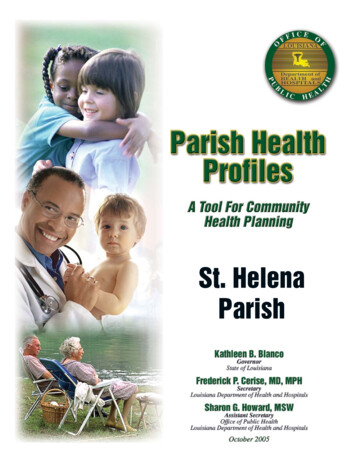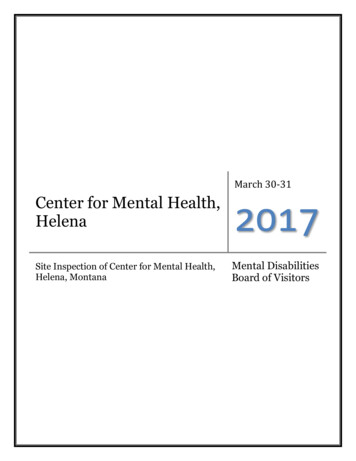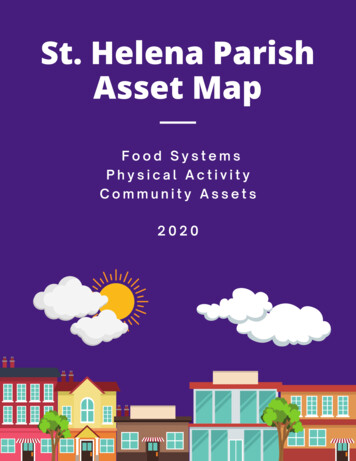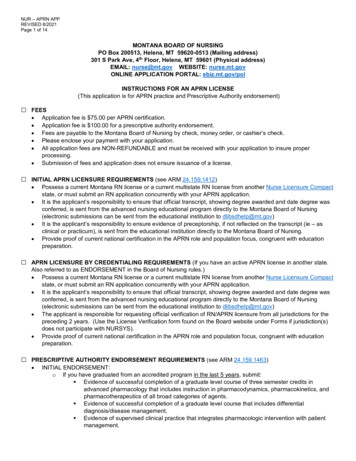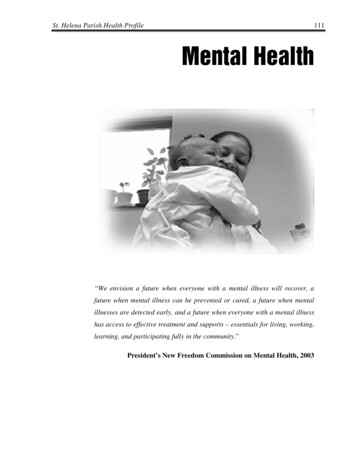
Transcription
St. Helena Parish Health Profile111Mental Health“We envision a future when everyone with a mental illness will recover, afuture when mental illness can be prevented or cured, a future when mentalillnesses are detected early, and a future when everyone with a mental illnesshas access to effective treatment and supports – essentials for living, working,learning, and participating fully in the community.”President’s New Freedom Commission on Mental Health, 2003
112 Mental HealthSt. Helena Parish Health ProfileOne-third of Americans between the ages of 15 and 54 will develop a mental illness in theirlives. According to data from the Substance Abuse and Mental Health ServicesAdministration (SAMHSA), 1 in 5 people experience a diagnosable mental disorder in anygiven year—for Louisiana this is an estimated 650,000 adults and 245,000 children.1In the chapter on “Using the Parish Profiles,” the broad definition of health was introduced.Part of that broad definition of health in a community is the concept of community mentalhealth, which may be reflected in all the aspects of that broad definition. Each communityneeds to decide how it will define the idea of community mental health status. The positiveassets of a community can significantly impact community and individual mental health.These positive qualities include a nurturing, tolerant, stimulating, diverse, safe and pleasantplace in which to live. Each community needs to decide what characteristics represent thepositive aspects of their community’s mental health. It is these positive aspects that are used,and improved on, in any community process to improve quality of life.However, most of the data that are collected nationallyand in Louisiana about mental health are based on a needfor individual mental health services, the use of thoseservices and additional community-based supportsystems that can be developed. Because of limitedresources, the individuals most likely to get services arethose with the most severe forms of mental illness.In Louisiana, it isestimated that 650,000adults and 245,000children have diagnosablemental illness.This section discusses the following indicators:Prevalence of mental illness for state and parish;mental illness diagnoses of clients served in state; andper capita mental health expenditure in Louisiana.Defining the Scope of Mental IllnessThe impact of mental illness and the promotion of mental health are major public healthconcerns, yet mental illness remains widely misunderstood. Mental illness is more commonthan any other major public health concern. It is morecommon than cancer, diabetes or heart disease. PsychiatricDID YOU KNOW?disorder is the number one reason for hospital admissionsy Approximately 18% of allnationwide. At any given moment, almost 21 percent of allchildren in foster care arehospital beds are filled by people with mental illness. Nearlyplaced in residentialeight million children and teens have serious emotionaltreatment facilities due toproblems. Mental illness is common in all walks of life. It istheir complex mentalhealth care needs eacha little known fact that many famous and influential peopleyear.have suffered from severe mental illness, including Abrahamy Nearly 40% of youth inLincoln, Beethoven, Van Gogh and Winston Churchill, tosecure care have a seriousname just a few.3emotional disturbancey 20% of inmates enteringprison receive mentalhealth services2Mental disorders fall along a continuum of severity. Themost serious and disabling conditions affect five to tenmillion adults (2.6% to 5.4% of the population) and three to
Mental HealthSt. Helena Parish Health Profile113five million children ages five to seventeen (5% to 9%) in the United States.4Serious mentalillness is defined as a diagnosable mental, behavioral, or emotional disorder that meetscriteria of the Diagnosis and Statistical Manual of Mental Disorders (DSM-IV – AmericanPsychiatric Association, 1994) and results in functional impairment substantially interferingwith or limiting one or more major life activities.5,6 Serious mental illness includesschizophrenia and psychotic disorder, major depression, and bipolar disorder.Despite its prevalence, only about one-thirdof those afflicted receive appropriate mentalhealth treatment yearly.7 Many of those whoare treated in hospitals or treatment centerswould be better served in less restrictive,more normalized, community-basedprograms. Other issues affecting those withmental illness are housing, employment, andovercoming the stigma of mental illnesses.Estimated Population withSevere Mental Illness, 2000St. 84,479194,261Source: Louisiana Department of Health and Hospitals,Based on national prevalence estimates usingFunding for mental health diagnoses,U.S. Census 2000treatment, and prevention comes fromMedicare (federal funds), Medicaid (state andfederal funds), state funds only, private insurance, and self-pay.8 Individuals with mentalillness can invest great expense over their lifetimes due to the high cost of care. As a result,there recently have been successful efforts to improve the mental health benefits of grouphealth care insurance plans, such as the Mental Health Parity Act of 1996.9Mental Health Reform –The President’s New Freedom Commission on Mental HealthReport (2003) has outlined a national agenda for reforming the mental health system in thenation making recommendations that enable adults with serious mental illnesses and childrenwith serious emotional disturbances to live, work, learn, and participate fully in theircommunities.10 To this end, in June of 2005, the Governor’s Health Care Reform Panelissued a report on mental health issues facing the state of Louisiana. The complete report isavailable on line at www.dhh.louisiana.gov, key words “health care reform”.Mental DisordersSevere mental illnesses, such as schizophrenia, major depression,and bipolar disorder, are biologically-based brain disorders.These disorders significantly disrupt a person’s ability to think,feel, and relate to others. These disorders are long lasting andepisodic. This means that they affect the person to some degreemost of his or her lifetime. State mental health services addressthe needs of people with severe mental illness. In Louisiana over90 percent of all people served through OMH have a severemental disorder.11 Many of the remainder of those served are atrisk for a severe disorder.DID YOU KNOW?Schizophrenia occursequally in both genders,and is usually diagnosedbetween 18 and 25 yearsof age. Men have aslightly earlier onset thanWomen. Onset ofsymptoms after the age of40 is rare.Office of Mental Health,2004
114 Mental HealthSt. Helena Parish Health ProfileSuicide Attempts andSelf-Inflicted Injuries1998-2001SuicideFrom 1998 until 2001, the rate for self-inflictedinjuries and suicide attempts in Louisiana was 38.2per 100,000 population (ages 10 years and up).12Teen suicide is the 3rd leading cause of death ofadolescents in Louisiana.13 For the same timeperiod, nearly 62 percent of the attempts were byfemales while just over 38 percent were attemptedby males. In looking at differences in age groups,persons in the 20-29 and 30-39 age groups havemore attempts while persons in the 60 years andolder have the fewest attempts.14 In St. HelenaParish from 1998-2001, there were less than 30suicide and self-inflicted injury attempts,therefore no rate was calculated.15Region 9Num berTotal485Num berRate per100,00032.3% of TotalBy Age Group10-1920-2930-3940-4950-5960 %By SexMale30963.7%Fem aleSource: Louisiana Hospital InpatientDischarge DatabaseCo-Occurrence of Serious Mental illness with Substance Abuse/DependenceMany people with a serious mental illness also suffer fromsubstance abuse/dependence. In 2003, the rate of adultswho were dependent on or abused alcohol or illicit drugswas 21 percent for adults with serious mental illness andonly 7.9 percent among those without serious mentalillness. An estimated 4.2 million adults met the criteria forboth serious mental illness and substance dependence orabuse in the past year. In 2004, the Office of Mental Healthand the Office of Addictive Disorders received a federalgrant to develop programs of integrated treatment to servethe needs of people with co-occurring serious mental illnessand substance abuse.1721% of adults withserious mental illnessare dependent on orabuse alcohol or illicitdrugs.16Primary Diagnoses of Clients Served bythe Louisiana Office of Mental Health, 2003-04ADULTSDiagnosisPercent of totaly Major affective disorder52.0%y Schizophrenia21.7%y Depressive disorder6.8%y Anxiety disorder3.5%y Mental retardation1.1%y Substance abuse disorder1.2%y Adjustment disorder1.0%y Personality disorder0.1%y Other13.6%CHILDRENDiagnosisPercent of totaly Attention deficit disorder 23.1%y Major affective disorder15.7%y Depressive disorder9.6%y Oppositional disorder6.6%y Anxiety disorder4.8%y Conduct disorder4.4%y Adjustment disorder3.8%y Schizophrenia.3%y Other8.7%Source: Office of Mental Health, 2004
St. Helena Parish Health ProfileMental Health115Addressing the Needs of Severe Mental IllnessCostsAccording to the 1999 Surgeon General’s Reporton Mental Health, it is estimated that the annualEach year, about one in foureconomic indirect cost of mental illness to United18States is 79 billion. Each year, about one inSocial Security disabilityfour Social Security disability payments are forpayments are for people withpeople with severe mental illness. In Louisianasevere mental illness.for the 2003/04 fiscal year, 45 percent of themental heath expenditures were for mental healthmedications.19 According to the NationalAssociation of State Mental Health Program Directors Research Institute, the total per capitamental health expenditures in Louisiana for 2003 was 51. This compares to 92.81 for theUnited States. Nationally, Louisiana ranked 27th in per capita mental health expenditures.20The Office of Mental Health budget has remained steady at about 50 million despite effortsover the years to increase this level of funding. These requests usually focus on pharmacy,housing, and children’s programs. Research evidence shows that improved access candirectly reduce the long-term costs of mental health care.21TreatmentThe treatment of mental disorders includes use of medications and a wide range ofcommunity-based treatment approaches. Providing support in the person’s naturalenvironment (e.g., work/school, home, community) can also help. There has been muchsuccess with community-based treatment approaches. When people are treated at home or ina community, they do not require hospitalization as often. Nationally, and in Louisiana, thereis an active agenda to reduce the number of people hospitalized and the length of hospitalstays. At the same time, OMH hopes to increase the available community-based care.22DID YOU KNOW?According to the NationalInstitute of Mental Health,individuals with seriousmental illness have a 90 %unemployment rate.23Medications have been a crucial factor to help people functionbetter and more independently. In recent years, there have beenamazing advances in the development of new antidepressantsand antipsychotic medications (e.g., clozapine, risperidone,olanzapine). These now have better results and fewer negativeside-effects. Obtaining funding for these newer, more effectivemedications has been an OMH priority over the past twoyears.24Access to Mental Health ServicesThe state mental health system in Louisiana includes 43 community mental health centersand 31 community outreach clinics. It also includes seven regional acute inpatient units, over300 contract community programs (e.g. crisis, case management and school-basedprograms), and five state psychiatric hospitals. Service delivery is organized into sixregionally integrated systems of care and four human service districts. These systems providea wide range of treatment and support services as close as possible to the client’s home.There are a growing number of state-of-the-art programs. This includes assertive community
116 Mental HealthSt. Helena Parish Health Profiletreatment and programs of housing. Employment and educationare also included. Within the Louisiana Medicaid Mental HealthRehabilitation Program, OMH supports the provision of servicesin home and community settings outside clinics through astatewide provider network of mental rehabilitation vendors. Foronline access to mental health support services offered by theOffice of Mental Health, visit the DHH Web site atwww.dhh.louisiana.gov.DID YOU KNOW?Visit the DHH Web site atwww.dhh.louisiana.gov foronline access to mentalhealth support servicesoffered by the Office ofMental Health. The sitefeatures a “clickable” statemap with detailedinformation by region.School-Based ServicesLouisiana school-based health centers (SBHC) provide mental health services to studentsincluding, but not limited to, crisis counseling, individual, family and group therapy. Schoolbased mental health services can facilitate access and target early intervention which canprevent school failure or involvement in the juvenile justice system.25 Each center is staffedwith a master’s level mental health professional who works closely with the center’s medicalpersonnel. Some centers also provide onsite psychiatric services. The emphasis is onprevention, early intervention and risk reduction. In 2003-2004, mental health was the secondleading reason for a visit to a school-based health center.26 Additional information onSBCHs, including a parish list, can be found in the Access to Appropriate Health Carechapter.Consumer, Family, and Community ServicesThere is growing consumer (service recipient) and family involvement in mental healthsystems planning, development, and evaluation. Mental health consumers are becomingpartners in decision-making regarding goals, programs and funding priorities. Communitiescan have direct impact on the availability and quality of services in their areas.27 InLouisiana, there are active and regionally representative state mental health planningcouncils, local advisory councils, and consumer/advocacy organizations. There are alsoorganizations for adult family members, such as the National Alliance for Mental Illness, andfor parents, and the Federation of Families for Children’s Mental Health. Two additionalagencies in Louisiana that provide statewide education and advocacy for the mental healthcommunity are the Mental Health Association (www.mhal.org/) and Meaningful Minds ofLouisiana (www.meaningfulmindsla.org). Both websites provide links to additional mentalhealth information and resources available throughout the state.Early Childhood Supports and Services (ECSS)—Identifies and mitigates the risks foryoung children, ages 0-5 years and their families, who are exposed to abuse, neglect,violence, parental mental illness, prenatal substance abuse, poverty, and developmentaldisabilities. ECSS brings together state agencies and local community organizations, such asHead Start and the March of Dimes, to identify these targeted children and refer them to theappropriate service. Currently the program is operating in nine parishes, including DeSoto,East Baton Rouge, Lafayette, Ouachita, Terrebonne, and St. Tammany. For more informationvisit the ECSS web site at www.ecssla.org.
St. Helena Parish Health ProfileMental Health117Community-Based SupportsCommunity capacity to support the preference of people with mental illnesses to liveindependently complements the basic treatment services provided by the Office of MentalHealth and other providers. Currently, OMH has programs to help consumers with housing,education, employment and business development. The focus there is not just treatment butreadiness for jobs and job skills, and supporting youth in their home and schoolenvironments.28HousingHousing is a critical need for people with serious mentalIn Louisiana over 3,500illnesses. OMH assists people with a mental illness withhousing and independent living. Supported housingpeople receiveservices include assistance with finding and keepingsupported housinghousing, moving expenses, local transportationservices each yearassistance, initial grocery expenses, baby-sitting andclothing needs. More support, such as an aide or intensesupport services, may be arranged at the beginning of independent living and tapered off inorder to make the transition easier. Over 3,500 people in Louisiana are served through thisprogram each year.29EducationSupported education provides individual and group support to students with serious mentalillness pursuing post-secondary education. The focus of supported education is to help thestudents handle academics and adapt to university life. Many students with severe mentalillness would ordinarily have difficulty staying in school and performing well. OMH operatestwo successful programs, one at Louisiana State University (LSU) in Baton Rouge and one atthe University of Louisiana (ULL) in Lafayette.30 Supported education is a national bestpractice, and Louisiana is proudly one of the few states offering this service.In 2003-2004, 172 students were served through the LSU program and 151 students wereserved through the ULL program. OMH hopes to make the program available for replicationin other Louisiana post-secondary institutions, including the new community college systemin the coming years.31EmploymentOMH recognizes that work is a major component in the recovery process and supportsconsumers in seeking, getting, and keeping a job. Traditionally, because an individual withsevere mental illness was considered unable to work, employment was seldom aconsideration in treatment planning. If placed, people with a mental illness were often put inlow-level, low-paying positions unrelated to their strengths or preferences. This has allchanged with the implementation of supported employment services.
118 Mental HealthSt. Helena Parish Health ProfileThe Office of Mental Health works closely with the Louisiana Rehabilitation Services toprovide supported employment services. OMH provides supported employment servicesacross the state, training consumers and establishing ties with the Louisiana RehabilitativeServices (Louisiana Department of Social Services) and establishing consumer-runbusinesses. There are trained consumer employment coordinators in every region of the state.Through these services, consumers are employed in meaningful jobs and better integratedinto the communities in which they live. In 2003-2004, OMH provided supportedemployment to over 1,500 consumers statewide.32A very successful consumer employment initiative has been the development of microenterprise, self-employment programs in partnership with the Louisiana RehabilitationServices (LRS). Micro-enterprises are sole proprietorship, partnerships, or family businesses.Consumers work with employment specialists to learn business skills and to develop andimplement business plans.The Community Can . . .Educate political, business and civic leaders on community-based mentalhealth services33y Identify gaps in existing service for persons with mental illnesses.34y Support peer-support groups for persons with mental illness.35,36y Support businesses in implementing work place mental health programs.37Toolkits & Guides:National Mental Health Association, The Village, www.nmha.org/pbeduadult/model/village.cfm.Peer Support Services, www.nmha.org/pbedu/adult/peerSupport.cfm.Promoting Mental Health in the Workplace, www.nmha.org/workplace/MH Workplace.pdf.Consumer-to-Consumer Outreach, .pdf.Develop and implement community-based support programs38y Increase the options for persons with mental illness to have safe, decent andaffordable housing.39y Support employment programs for persons with mental illness, such asLaHIRE.40y Support higher education programs for persons with mental illness.41Toolkits & Guides:An Advocate’s Guide to Expanding Housing Options for People who have Mental df.A Guide to Implementing Effective Employment Services for People with Psychiatric anual.pdf.On Our Own of Maryland, www.onourwnmd.org.Fast Track to Employment, www.nmha.org/pbedu/adult/model/fasttrac.cfm
St. Helena Parish Health ProfileMental HealthImprove adolescent mental healthy Support and implement school-based programs aimed at suicide prevention.y Conduct a suicide awareness and prevention week.42Toolkits & Guides:Yellow Ribbon Suicide Prevention Program, School or Community Based Suicide PreventionProgram, www.yellowribbon.org/.Yellow Ribbon International Suicide Awareness and Prevention Week . Louisiana Department of Health and Hospitals (LaDHH), “A Report on the State of the Mental Health DeliverySystem in Louisiana”, Governor’s Health Care Reform Panel, Jun2 2005.2. LaDHH, “A Report on the State of the Mental Health Delivery System in Louisiana.”3.National Alliance for the Mentally Ill.4. National Alliance for the Mentally Ill (NAMI), 2004, http://www.nami.org .5.American Psychiatric Association, 1994, Diagnostic and Statistical Manual of Mental Disorders (4th RevisedEdition). Washington, D.C:, American Psychiatric Association.6.Department of Health and Human Services, U.S. Public Health Service, Office of the Surgeon General 1999, MentalHealth: A Report of the Surgeon General. Rockville, MD.7.Department of Health and Human Services, U.S. Public Health Service, Office of the Surgeon General, 1999, MentalHealth: A Report of the Surgeon General.8. LaDHH, “A Report on the State of the Mental Health Delivery System in Louisiana.”9.Louisiana Department of Health and Hospitals, Office of Mental Health, 2004.10. New Freedom Commission on Mental Health. Achieving the Promise: Transforming Mental Health Care inAmerica, DHHS Pub. No. SMA-03-3832. Rockville, MD: 2003. http://www.mentalhealthcommission.gov .11.Louisiana Department of Health and Hospitals, Office of Mental Health, 2004.12.Louisiana Department of Health and Hospitals, Office of Public Health, Louisiana Hospital Inpatient DischargeDatabase 1998-2001, Prepared by: EMS/Injury Research & Prevention Program, Aug 2004.13. LaDHH, “A Report on the State of the Mental Health Delivery System in Louisiana.”14.Louisiana Department of Health and Hospitals, Office of Public Health (LaDHH/OPH) , Louisiana HospitalInpatient Discharge Database 1998-2001, Prepared by: EMS/Injury Research & Prevention Program, Aug 200415. LaDHH/OPH, Louisiana Hospital Inpatient Discharge Database 1998-200116.Louisiana Department of Health and Hospitals, Office of Mental Health, 2004.17.Louisiana Department of Health and Hospitals, Office of Mental Health, 2004.18. LaDHH, “A Report on the State of the Mental Health Delivery System in Louisiana.”19. LaDHH, “A Report on the State of the Mental Health Delivery System in Louisiana.”20. LaDHH, “A Report on the State of the Mental Health Delivery System in Louisiana.”21.Louisiana Department of Health and Hospitals, Office of Mental Health, 2004.22.Louisiana Department of Health and Hospitals, Office of Mental Health, 2004.23. LaDHH, “A Report on the State of the Mental Health Delivery System in Louisiana.”24.Louisiana Department of Health and Hospitals, Office of Mental Health, 2004.25. LaDHH, “A Report on the State of the Mental Health Delivery System in Louisiana.”26. LaDHH, “A Report on the State of the Mental Health Delivery System in Louisiana.”119
120 Mental HealthSt. Helena Parish Health Profile27.Louisiana Department of Health and Hospitals, Office of Mental Health, 2004.28.Louisiana Department of Health and Hospitals, Office of Mental Health, 2004.29.Louisiana Department of Health and Hospitals, Office of Mental Health, 2004.30.Louisiana Department of Health and Hospitals, Office of Mental Health, 2004.31.Louisiana Department of Health and Hospitals, Office of Mental Health, 2004.32.Louisiana Department of Health and Hospitals, Office of Mental Health, 2004.33.National Mental Health Association, Partners in CARE, Community Access to Recovery and Empowerment, 6 July2005 http://www.nmha.org/pbedu/adult/index.cfm .34.National Mental Health Association, Partners in CARE, Community Access to Recovery and Empowerment.35. National Mental Health Association, Partners in CARE, Peer Support Services 19 July 2005, http://www.nmha.org/pbedu/adult/peerSupport.cfm .36. National Mental Health Association, Consumer-to-Consumer Outreach, Mental Health Association of Tulsa, 18 July2005, Consumer.pdf .37.National Mental Health Association, “Promoting Mental Health in the Workplace”, 19 July 2005, http://www.nmha.org/workplace/MH Workplace.pdf .38.National Mental Health Association, An Advocate’s Guide to Expanding Housing Options for People who haveMental Illnesses, 19 July 2005, http://www.nmha.org/pbedu/adult/HousingManual.pdf. .39.National Mental Health Association, An Advocate’s Guide to Expanding Housing Options for People who haveMental Illnesses.40National Mental Health Association, A Guide to Implementing Effective Employment Services for People withPsychiatric Disabilities,19 July 2005, df .41.National Mental Health Association, Model Program, Supported Educations Community Action Group at theUniversity of Michigan, 20 July 2005, m .42. Yellow Ribbon International, Suicide Awareness and Prevention Week, 20 July 2005, http://www.yellowribbon.org/Week.html .
St. Helena Parish Health Profile Mental Health 113 Despite its prevalence, only about one-third St. Helena Louisiana Children 275 109,782 Adults 194 84,479 Total 469 194,261 Estimated Population with Severe Mental Illness, 2000 Source: Louisiana Department of Health and Hospitals, Based on national prevalence estimates using U.S. Census 2000
